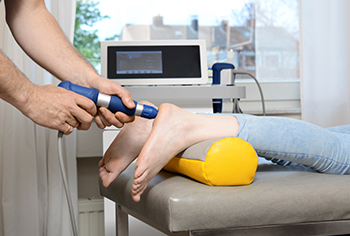Items filtered by date: August 2023
Shockwave Therapy for Plantar Fasciitis

Many people seek help for pain from plantar fasciitis, an inflammation of the band of tissue that runs beneath the foot from the toes to the heel. Some simple remedies for plantar fasciitis include rest, exercise, and medication. It has also been found that shockwave therapy can be effective in reducing pain and helping to heal the plantar fascia. This non-invasive treatment consists of applying penetrating waves of ultrasound energy into the inflamed area. The body responds by creating new blood vessels and stimulates nerve endings that can help to heal the area. While the treatment occurs without any surgery, it can be painful. Sometimes multiple treatments are required, depending on the severity of the plantar fasciitis. Results of shockwave therapy may vary, but most commonly the pain of plantar fasciitis subsides. Fortunately, there are many ways to treat symptoms of plantar fasciitis. Please consult a podiatrist for more information on the treatment options that are best for you.
Shockwave therapy is a treatment commonly used to treat various injuries and conditions, particularly plantar fasciitis in the feet. To learn more, consult with one of our podiatrists from Ankle and Foot Centers of Missouri, P.C.. Our doctors can provide the care you need to keep you pain-free and on your feet.
Shockwave Therapy
Shockwave therapy is a new treatment option designed to treat bone conditions such as tennis elbow, shoulder pain, and others. Shockwave therapy uses high intensity sound waves that are directed to the affected tissues of the body with pinpoint accuracy. The effects are very beneficial, leading to a production of collagen fibers, eliminating inflammation.
Who Benefits from Shockwave?
Shockwave is recommended for patients suffering from heel pain and associated problems. Heel pain is a common condition which can be caused by obesity, overexertion, and spending a substantial amount of time on hard floors with your feet exposed and unsupported.
Fast and Easy
The therapy is actually a simple process that can leave patients feeling better the very next day. Shockwave therapy is not as dramatic as it sounds. It enables more blood flow to effected areas, addressing the source of the problem and allowing treatment to last for a long time.
Treatment & Recovery Time
Shockwave treatment will enable your feet to recover quickly. This is especially important since surgery is not required. It is cost effective and does not require the use of anesthesia. This treatment is a better option to surgery, since it is proven safe.
If you have any questions, please feel free to contact our offices located in the Greater Kansas City area . We offer the newest diagnostic and treatment technologies for all your foot and ankle needs.
Are Bunions Affecting Your Everyday Life?
What Is a Good Foot Care Routine?

In the bustling rhythm of daily life, our feet often bear the brunt of our activities, yet they are often neglected when it comes to self care. Establishing a robust foot care routine, however, unveils a cascade of remarkable benefits. Regular exfoliation and moisturization not only soften the skin but also prevent unsightly issues such as calluses and cracked heels. This routine is not just about aesthetics, as it nurtures the foundation of our body's mobility. A soothing foot soak not only relaxes tired muscles but promotes blood circulation, enhancing overall well being. A well maintained foot care routine can improve posture and alleviate potential joint pain. If you would like to learn more about the benefits of practicing every day foot care routines, it is suggested that you consult a podiatrist who can provide you with important information.
Everyday foot care is very important to prevent infection and other foot ailments. If you need your feet checked, contact one of our podiatrists from Ankle and Foot Centers of Missouri, P.C.. Our doctors can provide the care you need to keep you pain-free and on your feet.
Everyday Foot Care
Often, people take care of their bodies, face and hair more so than they do for their feet. But the feet are a very important aspect of our bodies, and one that we should pay more attention to. Without our feet, we would not be able to perform most daily tasks.
It is best to check your feet regularly to make sure there are no new bruises or cuts that you may not have noticed before. For dry feet, moisturizer can easily be a remedy and can be applied as often as necessary to the affected areas. Wearing shoes that fit well can also help you maintain good foot health, as well as making it easier to walk and do daily activities without the stress or pain of ill-fitting shoes, high heels, or even flip flops. Wearing clean socks with closed shoes is important to ensure that sweat and bacteria do not accumulate within the shoe. Clean socks help to prevent Athlete’s foot, fungi problems, bad odors, and can absorb sweat.
If you have any questions please feel free to contact our offices located in the Greater Kansas City area . We offer the newest diagnostic and treatment technologies for all your foot and ankle needs.
All About Broken Toes

Recognizing and treating a broken toe is critical in preventing potential mobility and chronic pain issues. Severe pain following stubbing a toe or a heavy object falling on it may indicate a break or sprain. Symptoms of a broken toe can include throbbing pain at the point where the bone has fractured, swelling, bruising, and difficulty walking. There may also be a popping sound when a toe has fractured. A bad break can cause a dislocation of the toe, causing it to look deformed. For milder breaks, the buddy-taping method can stabilize the toe, while serious fractures may require surgery or a walking cast. Recovery may take several weeks to months, with gradual improvement in pain indicating healing. Wearing comfortable footwear and easing back into activities will help with recovery. If you think you have broken your toe, it is suggested that you make an appointment with a podiatrist for a definitive diagnosis and appropriate treatment.
Broken toes may cause a lot of pain and should be treated as soon as possible. If you have any concerns about your feet, contact one of our podiatrists from Ankle and Foot Centers of Missouri, P.C.. Our doctors will treat your foot and ankle needs.
What Is a Broken Toe?
A broken toe occurs when one or more of the toe bones of the foot are broken after an injury. Injuries such as stubbing your toe or dropping a heavy object on it may cause a toe fracture.
Symptoms of a Broken Toe
- Swelling
- Pain (with/without wearing shoes)
- Stiffness
- Nail Injury
Although the injured toe should be monitored daily, it is especially important to have a podiatrist look at your toe if you have severe symptoms. Some of these symptoms include worsening or new pain that is not relieved with medication, sores, redness, or open wounds near the toe.
If you have any questions, please feel free to contact our offices located in the Greater Kansas City area . We offer the newest diagnostic and treatment technologies for all your foot care needs.
Torn Ligaments in the Ankle

The main job of the ankle joint is to help you move your foot up and down. The ankle joint connects the leg and foot and is basically held together with tendons and ligaments. These are strong bands of tissue that provide stability. A torn ligament in the ankle can be caused by a twisting action, which stretches the ankle beyond its normal range. There are three categories of ligament tears, which depend on the severity of the injury. A grade 1 injury is deemed a minor, or micro, tear of the ligament. A grade 2 injury refers to a partial tear and may result in a loosening of the tissue. For these two types of injuries, rest and a type of brace or immobilizing device may be needed. A grade 3 injury is a complete tear of the ligament, however, and it almost always calls for surgical intervention to correct it. A podiatrist can determine the severity of the injury through imaging tests and based on that information prescribe the appropriate treatment program. For more information about a torn ankle ligament, it is suggested that you make an appointment with a podiatrist.
Although ankle sprains are common, they aren’t always minor injuries. If you need your ankle injury looked at, contact one of our podiatrists from Ankle and Foot Centers of Missouri, P.C.. Our doctors can provide the care you need to keep you pain-free and on your feet.
How Does an Ankle Sprain Occur?
Ankle sprains are the result of a tear in the ligaments within the ankle. These injuries may happen when you make a rapid shifting movement while your foot is planted. A less common way to sprain your ankle is when your ankle rolls inward while your foot turns outward.
What Are the Symptoms?
- Pain at the sight of the tear
- Bruising/Swelling
- Ankle area is tender to touch
- In severe cases, may hear/feel something tear
- Skin discoloration
Preventing a Sprain
- Wearing appropriate shoes for the occasion
- Stretching before exercises and sports
- Knowing your limits
Treatment of a Sprain
In many cases, the RICE method (Rest, Ice, Compression, and Elevate) is used to treat ankle sprains. However, you should see a podiatrist to see which treatment option would work best with your injury. In severe cases, surgery may be required.
It is important to ask your doctor about rehab options after you receive treatment for your injury. Stretching, strength training, and balance exercises may help the ankle heal while also preventing further injury.
If you have any questions, please feel free to contact our offices located in the Greater Kansas City area . We offer the newest diagnostic and treatment technologies for all your foot care needs.
Pain on the Top of the Foot and Front of the Ankle

Many individuals experience discomfort in the front of the ankle and the top of the foot, which can be attributed to various factors. Causes include plantar fasciitis, sprained ankles, foot or ankle arthritis, and prolonged wearing of ill-fitting shoes or high heels. Plantar fasciitis is characterized by pain on the bottom of the heel and arch, particularly noticeable after rest and during initial steps. The condition arises from the inflammation of the plantar fascia, a tissue band connecting the heel bone to the toes, and it can cause pain in the front of the ankle and top of the foot. A sprained ankle occurs when one or more ligaments in the ankle sustain injuries, leading to pain, swelling, bruising, and difficulty in walking. Arthritis, which involves joint inflammation and pain, can affect the foot or ankle, resulting in the type of discomfort mentioned above. Moreover, wearing overly tight shoes or high heels can create a slanted position for the foot, exerting pressure on the ball of the foot and toes, and contributing to the pain experienced. If you are encountering any of these types of foot and ankle pain, it is suggested that you seek the expertise of a podiatrist who can help identify the underlying cause of the discomfort and provide appropriate treatment options for relief.
Ankle pain can be caused by a number of problems and may be potentially serious. If you have ankle pain, consult with one of our podiatrists from Ankle and Foot Centers of Missouri, P.C.. Our doctors will assess your condition and provide you with quality foot and ankle treatment.
Ankle pain is any condition that causes pain in the ankle. Due to the fact that the ankle consists of tendons, muscles, bones, and ligaments, ankle pain can come from a number of different conditions.
Causes
The most common causes of ankle pain include:
- Types of arthritis (rheumatoid, osteoarthritis, and gout)
- Ankle sprains
- Broken ankles
- Achilles tendinitis
- Achilles tendon rupture
- Stress fractures
- Bursitis
- Tarsal tunnel syndrome
- Plantar fasciitis
Symptoms
Symptoms of ankle injury vary based upon the condition. Pain may include general pain and discomfort, swelling, aching, redness, bruising, burning or stabbing sensations, and/or loss of sensation.
Diagnosis
Due to the wide variety of potential causes of ankle pain, podiatrists will utilize a number of different methods to properly diagnose ankle pain. This can include asking for personal and family medical histories and of any recent injuries. Further diagnosis may include sensation tests, a physical examination, and potentially x-rays or other imaging tests.
Treatment
Just as the range of causes varies widely, so do treatments. Some more common treatments are rest, ice packs, keeping pressure off the foot, orthotics and braces, medication for inflammation and pain, and surgery.
If you have any questions, please feel free to contact our offices located in the Greater Kansas City area . We offer the newest diagnostic and treatment technologies for all your foot care needs.

